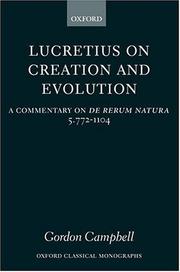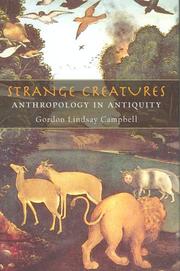| Listing 1 - 10 of 15 | << page >> |
Sort by
|
Book
ISBN: 3762520593 Year: 1982 Publisher: Wiesbaden Bauverlag
Abstract | Keywords | Export | Availability | Bookmark
 Loading...
Loading...Choose an application
- Reference Manager
- EndNote
- RefWorks (Direct export to RefWorks)
Art --- Painting --- anatomietekenen

ISBN: 0199263965 Year: 2003 Volume: *25 Publisher: Oxford [etc.] : Oxford University Press,
Abstract | Keywords | Export | Availability | Bookmark
 Loading...
Loading...Choose an application
- Reference Manager
- EndNote
- RefWorks (Direct export to RefWorks)
Creation in literature. --- Didactic poetry, Latin --- Evolution (Biology) in literature. --- Philosophy, Ancient, in literature. --- History and criticism. --- Creation in literature --- Evolution (Biology) in literature --- Philosophy, Ancient, in literature --- History and criticism --- Lucretius Carus, Titus. --- Lucretius Carus, Titus
Book
ISBN: 9780199589425 0199589429 Year: 2014 Publisher: Oxford, United Kingdom ; New York, NY, United State of America : Oxford University Press,
Abstract | Keywords | Export | Availability | Bookmark
 Loading...
Loading...Choose an application
- Reference Manager
- EndNote
- RefWorks (Direct export to RefWorks)
This book is the first comprehensive guide to animals in the ancient world, encompassing all aspects of the topic by featuring authoritative chapters on 33 topics by leading scholars in their fields. As well as an introduction to, and a survey of, each topic, it provides guidance on further reading for those who wish to study a particular area in greater depth. Both the realities and the more theoretical aspects of the treatment of animal's in ancient times are covered in chapters which explore the domestication of animals, animal husbandry, animals as pets, Aesop's 'Fables', and animals in classical art and comedy, all of which closely examine the nature of human-animal interaction. More abstract and philosophical topics are also addressed, including animal communication, early ideas on the origin of species, and philosophical vegetarianism and the notion of animal rights.--
Animals and civilization. --- Animals in art. --- Animals in literature. --- Animals and history. --- Human-animal relationships. --- Animaux et civilisation --- Animaux dans l'art --- Animaux dans la littérature --- Animaux et histoire --- Relations homme-animal --- Animaux dans la littérature

ISBN: 0715633910 9780715633915 Year: 2006 Publisher: London Duckworth
Abstract | Keywords | Export | Availability | Bookmark
 Loading...
Loading...Choose an application
- Reference Manager
- EndNote
- RefWorks (Direct export to RefWorks)
Anthropology --- Classical philology --- Anthropologie --- Philologie ancienne --- History --- Histoire
Book
ISBN: 0191035165 0191035157 0191750107 Year: 2014 Publisher: Oxford, England ; New York, New York : Oxford University Press,
Abstract | Keywords | Export | Availability | Bookmark
 Loading...
Loading...Choose an application
- Reference Manager
- EndNote
- RefWorks (Direct export to RefWorks)
This is a comprehensive guide to animals in the ancient world, encompassing all aspects of the topic by featuring authoritative chapters on 33 topics by leading scholars in their fields.
Animals and civilization --- Animals and history. --- Civilization, Ancient. --- History --- Human-animal relationships. --- Animals in literature. --- Animals in art. --- Animals and civilization.
Book
ISBN: 0521086868 Year: 1972 Publisher: Cambridge [Eng.] University Press
Abstract | Keywords | Export | Availability | Bookmark
 Loading...
Loading...Choose an application
- Reference Manager
- EndNote
- RefWorks (Direct export to RefWorks)
Book
ISBN: 0511760043 Year: 1973 Publisher: Cambridge : Cambridge University Press,
Abstract | Keywords | Export | Availability | Bookmark
 Loading...
Loading...Choose an application
- Reference Manager
- EndNote
- RefWorks (Direct export to RefWorks)
This book by Mr Glegg on the principles of the design process is concerned with carrying out the scientific research needed to obtain data for engineering design. He discusses the various kinds of experiments THAT are appropriate to particular situations and which are likely to yield the required data at minimum cost. Mr Glegg's objectives are essentially practical and he aims to help the designer, who often tends to become a specialist when he ought to be a general practitioner, to think through a research problem, even in an area totally outside the range of his previous experience. As in Mr Glegg's previous books, the principles are illustrated and brought home by further, often entertaining, examples from his wide range of experience as an inventor, consulting engineer, director of research and company director.
Book
ISBN: 0511760051 Year: 1972 Publisher: Cambridge : Cambridge University Press,
Abstract | Keywords | Export | Availability | Bookmark
 Loading...
Loading...Choose an application
- Reference Manager
- EndNote
- RefWorks (Direct export to RefWorks)
Mr Glegg writes about the adventure of inventing: where to begin, how to think about a problem, what principles to apply in tackling it, choosing between one possible design and another, and so on. He takes the reader through each of these stages in turn, illuminating his discussion with often highly entertaining examples from his own wide experience as an inventor, consulting engineer, company director and university teacher. Although he here adopts a more systematic approach than in his earlier book, The Design of Design, Mr Glegg's evident enjoyment of engineering is still apparent and is communicated to the reader. It is a book that will be especially helpful to the young designer who lacks experience and self-confidence, while also appealing to the old hand, who will find that he still has something fresh to learn from it.
Book
ISBN: 0511760035 Year: 1981 Publisher: Cambridge : Cambridge University Press,
Abstract | Keywords | Export | Availability | Bookmark
 Loading...
Loading...Choose an application
- Reference Manager
- EndNote
- RefWorks (Direct export to RefWorks)
How to develop a bright idea and how to decide if an invention is worthy of development? That is the theme of this entertaining book, which presents its message in a way that can be readily understood by anyone from a student to a senior consultant. The book is academically respectable without being obscure. The inventor is taught to be inventive and a scheme of scoring is suggested for assessing the viability of a new idea. The author illustrates his points with vivid and sometimes hilarious examples. He presents a pattern of thinking that can be applied to almost every area of engineering innovation. The book is based on the author's experiences as a successful consulting engineer; he has been variously an inventor, designer, company director, production manager, adviser to merchant bankers, he has headed research organisations, has lectured on the subject at the University of Cambridge, and is a chartered engineer.
Book
ISBN: 9780511760051 9780521086868 9780521113205 Year: 1972 Publisher: Cambridge Cambridge University Press
Abstract | Keywords | Export | Availability | Bookmark
 Loading...
Loading...Choose an application
- Reference Manager
- EndNote
- RefWorks (Direct export to RefWorks)
| Listing 1 - 10 of 15 | << page >> |
Sort by
|

 Search
Search Feedback
Feedback About UniCat
About UniCat  Help
Help News
News